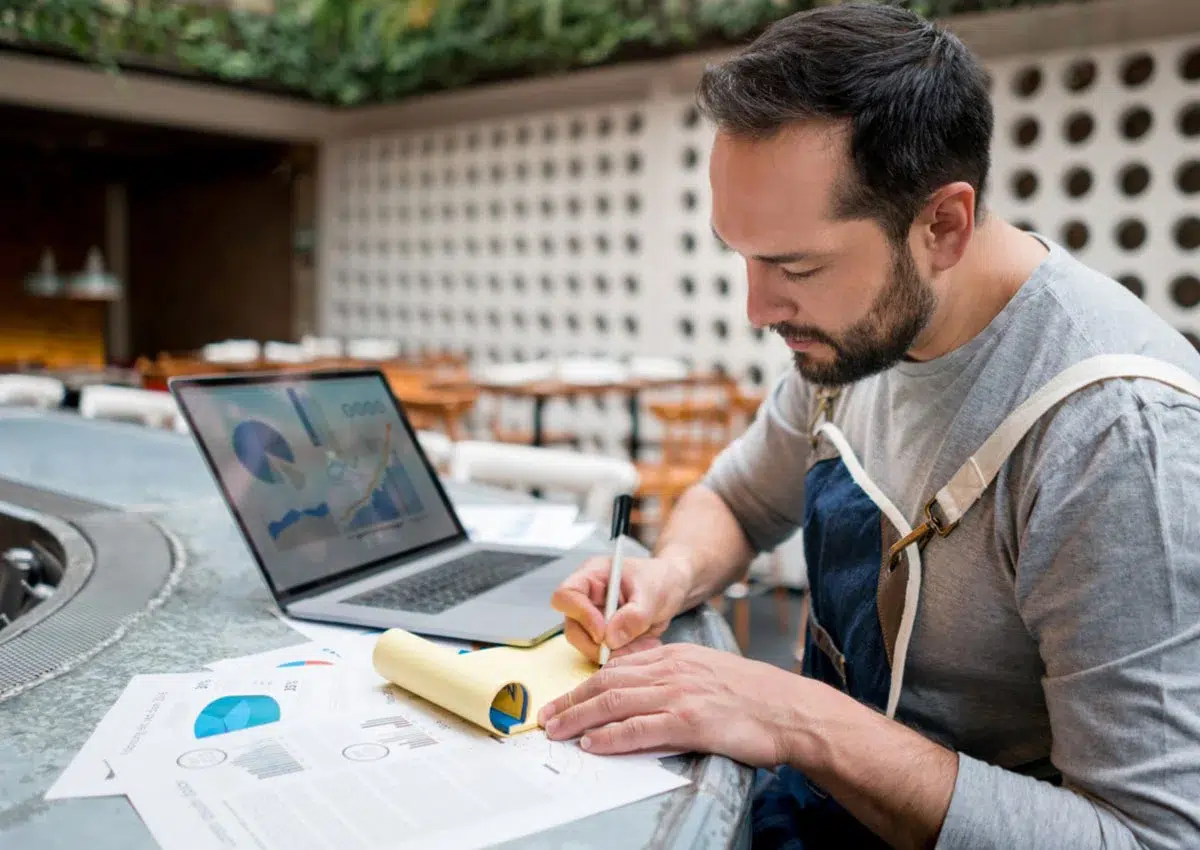Restaurant financing is the financial backbone that transforms culinary visions into thriving dining experiences. In the bustling world of hospitality, where flavors, experiences, and innovation come together, running a successful restaurant is both an art and a science. Behind the scenes of every delectable dish and memorable moment lies a complex web of financial considerations.
In this comprehensive guide, we’ll navigate the intricacies of restaurant financing, equipping you with insights to make informed decisions. We’ll delve into various restaurant funding options that can elevate your business to new heights. Whether you’re a startup seeking seed capital or an established eatery eyeing expansion, understanding the financial avenues at your disposal can spell the difference between culinary success and stumbling blocks.
What is restaurant financing?
Restaurant financing refers to the process of obtaining the necessary financial resources to establish, operate, expand, or enhance a restaurant business. It involves securing capital from various sources, such as loans, investments, and other funding avenues, to cover a range of expenses, including equipment purchases, location acquisition, staffing, marketing, and day-to-day operations.
Launching a restaurant is a blend of creativity and strategic planning. Before you open a restaurant, understanding restaurant startup costs can help you greatly.
Below are restaurant startup costs, as sourced from RestaurantOwner.com, to equip you with insights to navigate the financial landscape of your culinary vision.
Below are restaurant startup costs, as sourced from RestaurantOwner.com, to equip you with insights to navigate the financial landscape of your culinary vision.
- Low total cost to open $175,500
- Medium total cost to open $375,500
- High total cost to open $750,500
These figures represent overall costs for independent restaurants, but it’s important to acknowledge the multifaceted elements influencing these numbers.
- Construction $200,000
- Kitchen & Bar Equipment $95,000
- Pre-Opening & Training $20,000
Remember, these opening costs are subject to variation based on the specific type of restaurant you’re planning. The nature of your establishment defines these values – are you envisioning a full-service restaurant, a limited-service setup, or perhaps a lively bar or tavern?
This further brings us to the question– how to secure the capital to fund such restaurant expenses? Let’s delve into the strategies and restaurant funding options that can power your restaurant.
10 Restaurant financing options:
As you embark on this journey, understanding the spectrum of restaurant financing options is key to turning your vision into a thriving establishment. From traditional bank loans to crowdfunding platforms, these funding avenues offer restaurateurs the means to secure the necessary capital for a successful venture. Let’s explore the top 10 restaurant financing options for your restaurant.
1. Business Line of Credit
A business line of credit is a revolving credit source that allows restaurant owners to access funds up to a predetermined credit limit that can range from $5,000 to $1 million. This financing option is beneficial for managing short-term expenses and addressing fluctuations in cash flow.
Several payment plans will allow owners to pay it off at their own speed. Most have loan terms between six months to five years. Interest is only paid on the amount borrowed, making it a flexible financial tool.
2. Alternative Loans
In the landscape of restaurant financing, alternative loans present a dynamic and innovative approach. These loans are secured from non-traditional lenders, including online platforms and fintech entities. They offer a more flexible borrowing process, making them a viable choice for restaurant owners who may not meet the stringent criteria of traditional banks.
CAKE Capital has ventured into offering capital funding tailored to small businesses, with a particular focus on the restaurant industry. CAKE Capital’s white-label solution, powered by Parafin, provides restaurateurs with a reliable source of funding. This solution entails no risk or liability for Mad Mobile, alleviating concerns and fostering a secure financial environment.
3. Brick-and-mortar Bank Loan
A staple in restaurant financing, brick-and-mortar bank loans are obtained from traditional banks, providing a reliable source of capital. These loans are tailored to the specific financial needs of a restaurant and often require collateral to secure the loan. They offer structured repayment plans and competitive interest rates.
4. Equipment Financing
Kitchen equipment and furniture can be one of the highest opening costs. It depends on the size of your kitchen and dining room, but it’s essential to budget and plan for it.
Specifically designed for acquiring kitchen equipment and machinery, equipment financing helps restaurant owners keep their operations up-to-date. This financing option allows businesses to spread the cost of essential equipment over time, preserving working capital for other needs.
5. Merchant Cash Advance (MCA)
Merchant cash advances are suitable for restaurants with consistent credit card sales. This financing method provides a lump sum of cash up front, based on anticipated future credit card transactions. Repayment is linked to daily credit card sales, making it convenient but potentially more expensive than traditional loans.
6. Crowdfunding
Crowdfunding involves leveraging online platforms to gather contributions from a community of backers. It’s a collaborative way to secure funds for restaurant endeavors, often offering backers incentives or rewards in return for their support.
Many sites are accessible for crowdfunding, such as:
Each of these sites specializes in its own fixed or flexible funding. Some are better for personal financing like GoFundMe, versus equity crowdfunding like CircleUp. Kickstarter has a devoted section for restaurateurs seeking crowdfunding.
Because this is promoted on social media, it can reach a broad investor base.
7. Small Business Administration Loan (SBA)
Supported by the government, SBA loans are designed to aid small businesses, including restaurants. These loans provide favorable terms, lower interest rates, and longer repayment periods compared to conventional loans. SBA loans are particularly useful for restaurateurs looking for competitive financing options.
The business needs the following requirements to be eligible for this loan:
- Considered “small” by the SBA size standards
- For-profit
- Located in the United States
The SBA has three different kinds of commercial lending programs:
- SBA 7(a) Loan Program – Most flexible and can be used for most business purposes.
- CDC/504 Loan Program – Loans can go up to $13 million and can be used to fund large equipment and building purchases. These loans are strongly regulated, have low-interest rates, and long-term loans.
- Microloan Program – The SBA created this program for those who do not meet most commercial loan requirements. If you need an amount of $500 to $50,000, this loan option may suit you.
Get Connected
Need help finding a lender? Get connected via the SBA’s Lender Match website. It’s an online tool that connects small businesses with SBA-approved Community Development Financial Institutions (CDFIs) and other various lenders. Here’s how it works on Lender Match:
- Describe your needs
- Get matched in 2 days
- Talk to lenders
- Apply for a loan
Use the Lender Match program to get connected with a small business lender near you. Each lender will have different requirements in the application.
8. Commercial Real Estate (CRE) Loans
If restaurant owners aspire to own their physical space, a commercial real estate loan is an option to consider. This loan assists in purchasing property, enabling restaurateurs to establish a permanent location for their culinary venture.
The property itself serves as the collateral for this type of loan. Commercial real estate loans can come from lenders and banks. The amount can range from $200,000 to over 20 million. Rates are typically between 5% to 30% and on a loan term of 20 to 25 years.
9. Funds or Loans from Friends and Family
Borrowing from friends and family is a common route for restaurant financing. This approach can offer more flexible terms and minimal interest compared to traditional loans. However, clear communication and terms are essential to avoid straining personal relationships.
10. Purchase Order Financing
Purchase order financing is particularly useful for restaurants with supply chain needs. This option ensures you can fulfill orders without depleting your working capital, as the financier covers the cost of goods needed to fulfill a purchase order.
Exploring these financing avenues empowers restaurant owners to choose the option that aligns best with their specific financial needs and aspirations.
How to evaluate which financing option is best for your restaurant
Choosing the most suitable financing avenue for your restaurant is a pivotal decision that demands careful evaluation. To ensure you make an informed choice, consider the following factors:
1. Pros and Cons: Begin by dissecting the advantages and drawbacks of each financing option. Assess how well each aligns with your restaurant’s unique needs, goals, and financial capabilities. Balance the benefits against potential challenges to gauge overall suitability.
2. Risk Assessment: Analyze the risk associated with each financing method. Determine whether collateral, such as assets or property, is required to secure the loan. Understand the implications of these requirements and evaluate if you are comfortable taking on the associated risk.
3. Fixed vs. Variable Payments: Distinguish between fixed-rate and variable-rate payment structures. Fixed-rate payments offer stability, ensuring consistent monthly payments throughout the loan term. In contrast, variable-rate payments may fluctuate based on market conditions, potentially impacting on your financial stability.
4. Capital Accessibility: Evaluate how quickly you can access the funds. Some financing options provide swift access to capital, while others may involve a lengthier application and approval process. Consider your restaurant’s urgency for funding and choose an option that aligns with your timeline.
Navigating the intricate web of financing options demands a thorough understanding of your restaurant’s financial landscape, objectives, and risk tolerance. By meticulously weighing the pros and cons, assessing associated risks, comprehending payment structures, and gauging capital accessibility, you can confidently select the financing option that paves the way for your restaurant’s success.
What to do before securing financing for your restaurant
Before embarking on the journey of securing financing for your restaurant, a few crucial steps can set the stage for a successful financial endeavor:
- Write or Revamp Your Business Plan: A well-structured business plan serves as the blueprint for your restaurant’s success. If you already have one in place, review and update it to reflect current market conditions, goals, and financial projections. For those starting from scratch, craft a comprehensive plan that outlines your restaurant concept, target audience, competition analysis, marketing strategies, and financial forecasts. A robust restaurant business plan not only provides clarity to potential lenders but also assists you in strategizing for the future.
- Determine How Much Funding You Need: Precisely estimating your funding requirements is essential. Carefully assess the costs associated with opening or expanding your restaurant, including real estate, equipment, furnishings, staffing, marketing, and working capital. Be thorough in your calculations and consider potential contingencies. This clear understanding of your financial needs will guide you in selecting the appropriate financing option and prevent underestimation or over-borrowing.
The Bottom Line
In the dynamic landscape of restaurant financing, informed decisions are the cornerstone of success. By comprehending the diverse financing options, evaluating their suitability, and preparing thoroughly, you lay the groundwork for a thriving culinary venture. As you embark on this financial journey, remember that knowledge is your ally. To delve deeper into the world of restaurant ownership, financing, and successful operations, explore our range of resources:
CAKE POS for Small Businesses: Discover how our CAKE POS system can streamline operations and enhance profitability for small restaurant businesses.
Restaurant Ownership Insights: Gain valuable insights into the nuances of restaurant ownership, from concept development to effective management.
5 Things to Know When Opening a Restaurant: Uncover five key considerations that every aspiring restaurant owner should be aware of before launching their culinary enterprise.





